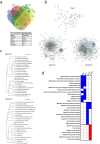Duchenne muscular dystrophy gene expression is an independent prognostic marker for IDH mutant low-grade glioma
- PMID: 35217778
- PMCID: PMC8881458
- DOI: 10.1038/s41598-022-07223-2
Duchenne muscular dystrophy gene expression is an independent prognostic marker for IDH mutant low-grade glioma
Abstract
Alterations in the expression of the Duchenne muscular dystrophy (DMD) gene have been associated with the development, progression and survival outcomes of numerous cancers including tumours of the central nervous system. We undertook a detailed bioinformatic analysis of low-grade glioma (LGG) bulk RNAseq data to characterise the association between DMD expression and LGG survival outcomes. High DMD expression was significantly associated with poor survival in LGG with a difference in median overall survival between high and low DMD groups of over 7 years (P = < 0.0001). In a multivariate model, DMD expression remained significant (P = 0.02) and was an independent prognostic marker for LGG. The effect of DMD expression on overall survival was only apparent in isocitrate dehydrogenase (IDH) mutant cases where non-1p/19q co-deleted LGG patients could be further stratified into high/low DMD groups. Patients in the high DMD group had a median overall survival time almost halve that of the low DMD group. The expression of the individual DMD gene products Dp71, Dp71ab and Dp427m were also significantly associated with overall survival in LGG which have differential biological effects relevant to the pathogenesis of LGG. Differential gene expression and pathway analysis identifies dysregulated biological processes relating to ribosome biogenesis, synaptic signalling, neurodevelopment, morphogenesis and immune pathways. Genes spanning almost the entirety of chromosome 1p are upregulated in patients with high overall DMD, Dp71 and Dp427m expression which worsens survival outcomes for these patients. We confirmed dystrophin protein is variably expressed in LGG tumour tissue by immunohistochemistry and, overall, demonstrate that DMD expression has potential utility as an independent prognostic marker which can further stratify IDH mutant LGG to identify those at risk of poor survival. This knowledge may improve risk stratification and management of LGG.
© 2022. The Author(s).
Conflict of interest statement
The authors declare no competing interests.
Figures









References
-
- Ash A, Machado L, Raleigh SM, Anthony K. Neuropathophysiology of Duchenne muscular dystrophy: Involvement of the dystrophin isoform Dp71 in cell migration and proliferation. Neuromuscul. Disord. 2018;28:S13–S14. doi: 10.1016/S0960-8966(18)30328-6. - DOI
MeSH terms
Substances
Grants and funding
LinkOut - more resources
Full Text Sources
Medical

